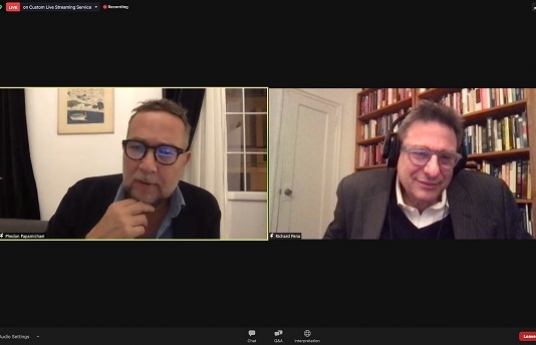The art of cinematography is ‘not great shots or camera moves’ but telling the story, says Qumra Master Phedon Papamichael
Mar 16, 2021

- Masterclass by Academy Award-nominated and internationally acclaimed cinematographer underlined the importance of focusing on performances and characters
Doha, Qatar; March 16, 2021: It was a masterclass with a difference: Academy Award-nominated and internationally acclaimed cinematographer and Qumra Master Phedon Papamichael took audiences through a spell-binding journey of his ouvre of films, all the while maintaining that ‘cinematography is not about great shots or camera moves but telling the story and bringing out the performances’.
The timing could not have been better: The day of his masterclass closed with news that he had received yet another Academy Award nomination for his work in The Trial of the Chicago 7, directed by Aaron Sorkin, whom he praised for his writing. “The film is written like a play set in a courtroom intercut with vignettes. The challenge for me was to able to shoot the courtroom in a compact way.”
In the session moderated by Richard Peña, the Programme Director of the Film Society of Lincoln Center and the Director of the New York Film Festival from 1988 until 2012, at Qumra 2021, the Doha Film Institute’s annual talent incubator for Arab cinema, Papamichael also provided an insider view of Hollywood, working with some of the all-the-time greatest directors and being part of several timeless classics.
Describing his move to cinema from being a still photographer, Papamichael said: “One of the movies that influenced me was Contempt (Le Mepris), [the 1963 French New Wave drama by Jean-Luc Godard]. It made a strong first impression because of its atypical approach and graphic composition.” His father was a painter and art director, so ‘there was some connection.’
But what really changed with watching Contempt was that it instilled in Papamichael the belief that “I could apply my visual interest and also tell a story unlike still photography, which was a very lonely profession. It was me and myself, and I would be destroying a moment – not capturing it or busy capturing it – without taking the moment in and observing.” Cinema fascinated him because he was “given a story where I could apply my visual interpretation.”
Describing himself as self-taught, he says he too benefited form the school of Roger Corman, the prolific film director called ‘The Pope of Pop Cinema.’ This led to Papamichael collaborating with Katt Shea on films such as Dance of the Damned and Stripped to Kill II: Live Girls, both emerging from the three sets that Corman maintained to make a flurry of movies. “It was a real film school; we had 15 days to do a feature.” It was learning on the go for Papamichael because “Roger never cared about what we did stylistically.”
A milestone in his career was Cool Innings, a comedy sports film, starring John Candy – “the most brilliant man to hang out with” – which Papamichael says was “a formula sports movie that just became a cult classic. He also described his work on 3:10 to Yuma, the western action drama, directed by James Mangold and starring Russel Crowe and Christian Bale. He said the challenge in doing the film, especially some of its high-wattage action shots, was “to think fast. It was the hardest movie physically but very rewarding ultimately.” He said several key scenes were not rehearsed and “we took advantage of not preconceiving too much. I am fortunate to have worked with directors like Mangold, who are not scared to work off the storyboard and be reactive.”
The lesson for aspiring filmmakers from Papamichael is to “look at great actors and what they do and respond accordingly. Take advantage of the gems they give us. The key, even in action sequences, is to connect audiences to the protagonist. It is all about the character. That is a lesson I learnt from Mangold and Alexander Payne – it is not the genre that matters; it is the character.”
Talking about another seminal work of his, Walk the Line, the biopic on Johnny Cash starring Joaquin Phoenix and Reese Witherspoon, and directed by Mangold, Papamichael reiterated the need to be reactive, “to go with the flow.”
He also discussed the making of Sideways and Nebraska, both directed by Payne, the latter in black and white. For Sideways, “for the first time we used two cameras to capture the overlapping performances though Alexander was not used to multiple cameras. Nebraska, on the other hand, was shot on a single camera. I like to see the performances actors bring in. Being reactive and taking advantage of what actors deliver is what matters. I have discovered that film is about telling the story. The moment I am conscious of the camera and think about the camera work or lighting, the story is lost on me.”
On making Nebraska in black and white, Papamichael said it “was appropriate to the theme of the film of isolation and loneliness. As they say, black and white is an actor’s best friend; it helps you focus on the character without distractions from the colour palette.”
Public can access Qumra online by purchasing a Qumra Pass that offers the full Qumra Screenings and Qumra Talks programmes. Qumra Pass is open to all citizens and residents of Qatar and the MENA region, and applications will be processed on a first-come first-serve basis. The Qumra Pass is priced at QAR 500; students and Culture Pass by Qatar Museums holders can purchase it for a discounted price of QAR 350.